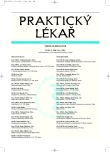-
Medical journals
- Career
Clinical aspects and neurobiology of Alzheimer’s disease
Authors: F. Koukolík
Authors‘ workplace: Primář: MUDr. František Koukolík, DrSc. ; Národní referenční laboratoř prionových chorob ; Fakultní Thomayerova nemocnice s poliklinikou, Praha ; Oddělení patologie a molekulární medicíny
Published in: Prakt. Lék. 2007; 87(8): 474-478
Category: Various Specialization
Overview
Alzheimer’s disease (AD) is a silent epidemic involving the elderly and is one of most frequent causes of death in the adult population. Probable and possible diagnosis of AD is a clinical one and is based on international criteria. The definitive diagnosis of AD is neuropathological. The diagnosis of mild cognitive impairment has a fundamental role in the differential diagnosis of evolving AD. Early form AD concerns the population up to 65 years, late form AD affects individuals between 65 and 84 years old, and very late form AD occurs in the 85+ population. Familiar forms of AD constitute 5–10 % of all cases, whilst sporadic forms account for the remaining 90–95%. The amyloid cascade hypothesis is a fundamental hypothesis for the so-called “Baptists”. “Tauists” focus on the metabolism of tau protein. Both hypotheses share some common factors. The pathogenesis of AD involves apoptosis of neurons, inflammatory mechanisms and vascular pathology. Signs and symptoms of AD (e.g. impairment of recent episodic and then of semantic memory, special disorientation, altered emotivity, language and executive functions) are in some correlation with the distribution of neuronal tangles and neuritic plaques.
Key words:
Alzheimer’s disease, epidemiology, pathogenesis, brain-behaviour correlation.
Labels
General practitioner for children and adolescents General practitioner for adults
Article was published inGeneral Practitioner

2007 Issue 8-
All articles in this issue
- Plant dermatitis The author aims to provide
- Pulmonary embolism
- Interstitial lung diseases - survey, differential diagnosis and methods of investigation
- Extrinsic allergic alveolitis
- Clinical aspects and neurobiology of Alzheimer’s disease
- Are GP’s notions of how patients adhere to treatment regimes real?
- Head and facial pains brought on by ENT diseases
- Analysis of opinions and positions of physicians regarding physical activity as a means of health prevention
- Advanced organ complications as the manifestation of undertreated diabetes mellitus in a 41- year old woman.
- Isolated arrhythmogenic left ventricular cardiomyopathy with signs of lipomatous dysplasia.
- General Practitioner
- Journal archive
- Current issue
- Online only
- About the journal
Most read in this issue- Interstitial lung diseases - survey, differential diagnosis and methods of investigation
- Extrinsic allergic alveolitis
- Head and facial pains brought on by ENT diseases
- Plant dermatitis The author aims to provide
Login#ADS_BOTTOM_SCRIPTS#Forgotten passwordEnter the email address that you registered with. We will send you instructions on how to set a new password.
- Career

